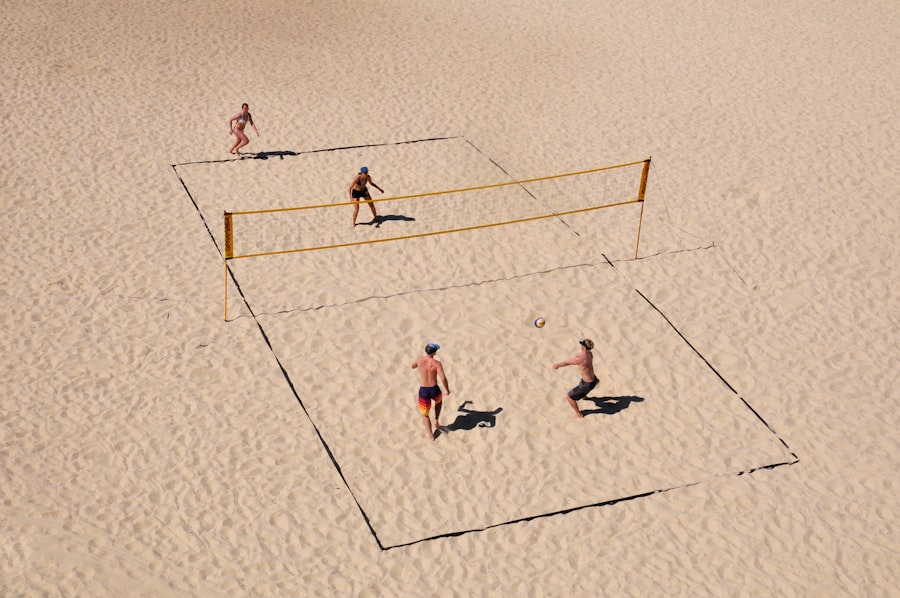Mastering the Art of Volleyball: Tips for Success
Description
Volleyball is a dynamic sport that combines elements of strategy, athleticism, and teamwork. Originating in the United States in 1895, it has evolved into a global phenomenon, played both indoors and on the beach. The game is played by two teams, each consisting of six players, who aim to score points by sending a ball over a net and into the opposing team’s court.
The fundamental objective is to ground the ball on the opponent’s side while preventing them from doing the same. Each team is allowed three touches to return the ball, which introduces a layer of complexity as players must work together to execute plays effectively. The court dimensions and rules are essential to grasping the game.
A standard indoor volleyball court measures 18 meters long and 9 meters wide, divided by a net that stands at 2.43 meters high for men and 2.24 meters for women.
This system not only accelerates the pace of the game but also increases the excitement for players and spectators alike.
Understanding these basics lays the groundwork for players to develop their skills and strategies as they progress in the sport.
Key Takeaways
- Volleyball is a team sport played with a ball and a net, with the objective of sending the ball over the net and into the opponent’s court.
- Proper technique in volleyball involves mastering skills such as serving, passing, setting, hitting, and defensive strategies.
- Improving footwork and agility is essential for success in volleyball, as it allows players to move quickly and efficiently on the court.
- Communication and teamwork are crucial in volleyball, as players need to work together to anticipate and react to the opponent’s moves.
- Enhancing serving and passing skills, as well as perfecting setting and hitting techniques, are key components of becoming a skilled volleyball player.
- Learning defensive strategies is important in volleyball, as it helps players anticipate and react to the opponent’s attacks.
- Mental preparation and focus are essential for success in volleyball, as they help players stay calm and focused during intense game situations.
Developing Proper Technique
Mastering volleyball requires a solid foundation in technique, which encompasses various skills such as serving, passing, setting, and hitting.
For instance, when serving, players must focus on their stance, grip, and follow-through to ensure accuracy and power.
A well-executed serve can put immediate pressure on the opposing team, making it a critical skill to develop early on. Passing, often referred to as “bumping,” is another fundamental technique that requires precision and timing. Players must position themselves correctly to receive the ball and use their forearms to create a stable platform for accurate passes.
The technique involves bending the knees and keeping the arms straight, which allows for better control of the ball’s trajectory. Coaches often emphasize repetitive drills to help players internalize these techniques, ensuring that they can execute them instinctively during matches.
Improving Footwork and Agility

Footwork is a crucial aspect of volleyball that directly impacts a player’s ability to perform various skills effectively. Quick and agile footwork allows players to position themselves optimally for receiving serves, making accurate passes, or executing powerful hits. Training drills focused on lateral movement, quick pivots, and explosive sprints can significantly enhance a player’s agility on the court. For example, ladder drills are commonly used to improve foot speed and coordination, enabling players to move swiftly in any direction. In addition to agility drills, strength training plays a vital role in developing footwork.
Strong legs contribute to better balance and stability, which are essential when jumping for blocks or spikes. Plyometric exercises such as box jumps or jump squats can help build explosive power in the legs, allowing players to elevate more effectively during play. By combining agility training with strength-building exercises, athletes can create a well-rounded approach to improving their footwork.
Mastering Communication and Teamwork
| Metrics | 2019 | 2020 | 2021 |
|---|---|---|---|
| Teamwork effectiveness | 85% | 88% | 90% |
| Communication skills training hours | 20 | 25 | 30 |
| Employee satisfaction with communication | 75% | 80% | 85% |
Volleyball is inherently a team sport that relies heavily on effective communication among players. Successful teams often exhibit strong verbal and non-verbal communication skills that facilitate seamless coordination during matches. Players must call for the ball, signal their intentions, and provide encouragement to one another throughout the game.
Establishing clear communication protocols can help reduce confusion and enhance overall team performance. Teamwork extends beyond mere communication; it involves understanding each player’s strengths and weaknesses and leveraging them strategically during play. Coaches often encourage team-building exercises that foster trust and camaraderie among players.
For instance, engaging in drills that require players to rely on one another can help build synergy on the court. When players understand each other’s playing styles and tendencies, they can anticipate movements and react more effectively during critical moments in a match.
Enhancing Serving and Passing Skills
Serving is one of the most critical skills in volleyball as it initiates each rally. There are various types of serves—underhand, overhand, jump serves—each requiring different techniques and levels of skill. The jump serve, for instance, adds an element of unpredictability due to its height and speed, making it challenging for opponents to receive.
Players must practice their serving techniques consistently to develop accuracy and power while also learning how to read the opposing team’s formation to exploit weaknesses. Passing is equally vital as it sets up offensive plays. A well-executed pass can determine the success of an attack.
Players should focus on developing their passing techniques through repetitive drills that emphasize body positioning and hand-eye coordination. For example, practicing with a partner or against a wall can help improve reaction times and accuracy in passing. Additionally, understanding how to read the trajectory of incoming serves or attacks allows players to position themselves better for effective passes.
Perfecting Setting and Hitting Techniques

Mastering the Art of Setting
Setting is a highly intricate skill in volleyball, requiring both technical proficiency and a deep understanding of timing and spatial awareness. A setter must be able to deliver accurate sets that allow hitters to attack effectively, which involves mastering hand positioning, footwork, and body alignment to ensure that sets are delivered at the right height and location for hitters to make successful attacks.
The Nuances of Hitting Techniques
Hitting techniques also demand significant practice and refinement. Players must learn how to approach the net correctly, jump at the right moment, and execute powerful swings while maintaining control over their body position. The timing of the jump is crucial; hitters must synchronize their leap with the setter’s delivery to maximize their hitting potential.
Practicing Under Pressure
Coaches often implement drills that simulate game situations, allowing hitters to practice their timing and technique under pressure. This helps players develop the skills and confidence they need to perform at their best in high-stakes games.
Learning Defensive Strategies
Defensive strategies are essential for any volleyball team aiming for success on the court. Players must be equipped with skills such as digging—defending against attacks—and blocking—preventing opponents from scoring at the net. Digging requires quick reflexes and an understanding of how to position oneself relative to incoming attacks.
Players often practice digging by working with partners who simulate various types of hits, allowing defenders to hone their reaction times. Blocking is another critical defensive skill that involves timing jumps and positioning hands effectively to intercept attacks at the net. A successful block can not only prevent points but also shift momentum in favor of the defending team.
Players must learn how to read hitters’ body language and anticipate their movements to time their jumps accurately. Coaches frequently emphasize teamwork in defense; effective communication among blockers can lead to more successful defensive plays.
Mental Preparation and Focus
Mental preparation is an often-overlooked aspect of volleyball that can significantly impact performance on the court. Athletes must cultivate focus and resilience to navigate the pressures of competition effectively. Visualization techniques can be beneficial; players may visualize successful plays or positive outcomes before matches to boost confidence levels.
This mental rehearsal helps athletes prepare for various scenarios they may encounter during gameplay. Additionally, maintaining composure during high-pressure situations is crucial for success in volleyball. Players should develop strategies for managing anxiety or stress that may arise during matches.
Techniques such as deep breathing exercises or mindfulness practices can help athletes stay centered and focused on their performance rather than external distractions. By prioritizing mental preparation alongside physical training, players can enhance their overall performance and contribute positively to their team’s success on the court.
If you’re a fan of volleyball, you may also be interested in checking out this article about the Panini Sticker Album here. This collection of stickers featuring various volleyball players and teams can be a fun way to engage with the sport off the court.
FAQs
What is volleyball?
Volleyball is a team sport in which two teams of six players are separated by a net. The objective is to score points by grounding the ball on the opposing team’s court.
What are the basic rules of volleyball?
The basic rules of volleyball include serving the ball over the net, rallying to keep the ball in play, and trying to score points by grounding the ball on the opposing team’s court. Each team is allowed three touches to return the ball.
What are the different types of volleyball games?
There are several variations of volleyball, including indoor volleyball, beach volleyball, and sitting volleyball. Each variation has its own set of rules and playing environment.
What equipment is needed to play volleyball?
The main equipment needed to play volleyball includes a volleyball, a net, and appropriate footwear. Players may also wear knee pads and other protective gear.
What are the health benefits of playing volleyball?
Playing volleyball can improve cardiovascular health, enhance muscle strength and coordination, and promote teamwork and social interaction. It is also a great way to stay active and have fun.
What are the key skills needed to play volleyball?
Key skills needed to play volleyball include serving, passing, setting, attacking, blocking, and digging. Players also need good communication and teamwork skills.





